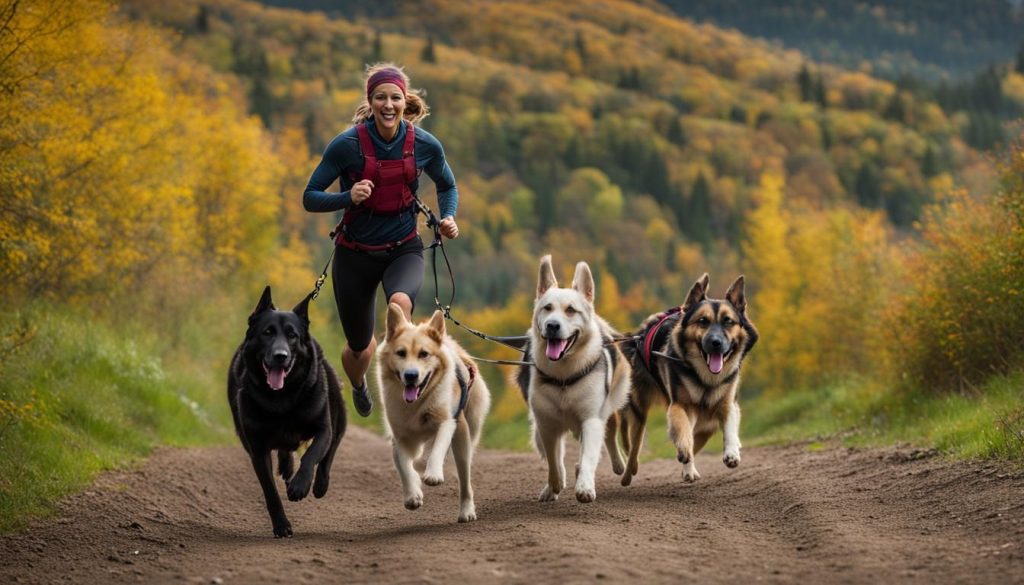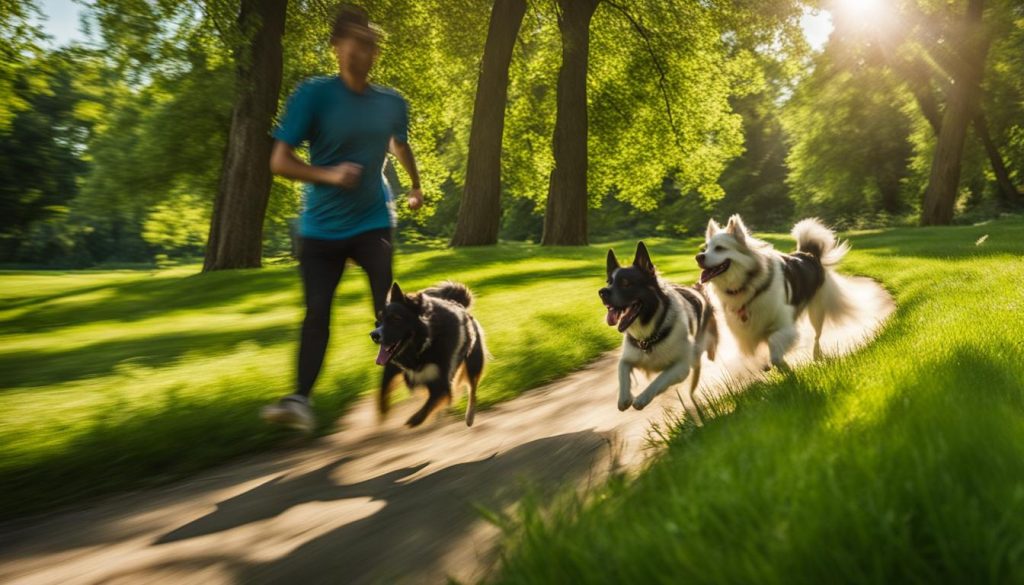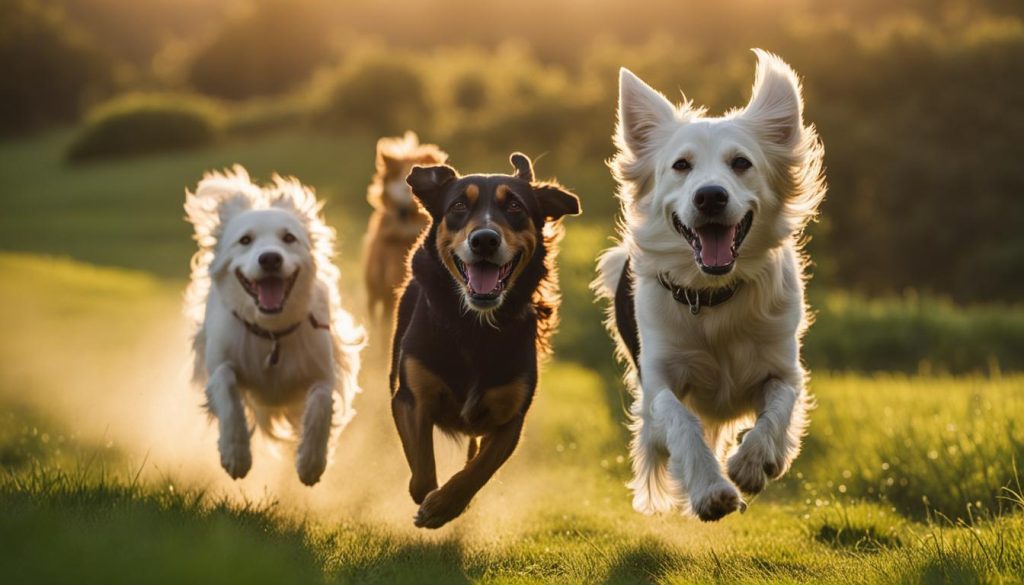Running with two dogs is not only a fantastic way to stay fit, but it also provides an opportunity to bond with your furry companions. Whether you’re an experienced runner or just starting out, incorporating your dogs into your jogging routine can add an extra level of fun and motivation. In this guide, I will share some valuable tips and guidelines to help you make the most out of your runs with two dogs.
Key Takeaways:
- Running with two dogs can maximize your fitness while enhancing the bond between you and your canine companions.
- Start by gradually training your dogs for longer runs and allow them to develop their own pacing and rhythm.
- Minimize sniffing during runs to maintain a steady pace and choose wide paths to avoid distractions.
- Use positive reinforcement techniques to encourage good behavior and create a comfortable running experience for your dogs.
- Invest in quality leashes and harnesses to maintain control and ensure the safety of both you and your dogs.
Get Your Dogs in Shape
Before embarking on long runs with two dogs, ensure that they are in good physical condition. Training with a dog and establishing a running routine with multiple dogs can help prepare them for the challenges of running and maximize their performance. I highly suggest that you start slow and gradually increase the distance and intensity of the runs.
Each dog may have their own pacing and endurance levels, so let them develop their own rhythm. Some dogs may be more energetic and have a higher stamina, while others may need more time to build their endurance. By allowing them to find their comfortable pace, you are setting them up for a successful and enjoyable running experience.
Training Tips for Running with Two Dogs:
- Establish a training routine: Dedicate shorter runs to train your dogs and work on their obedience skills. This will help them learn to run alongside you and follow commands.
- Use positive reinforcement: Reward your dogs with treats and praise when they exhibit good running behavior. This will encourage them to stay by your side and maintain a steady pace.
- Gradually increase distance: Start with shorter runs and gradually increase the distance over time. This will allow your dogs to build their endurance and avoid overexertion.
- Monitor their health: Pay attention to any signs of fatigue or discomfort during and after the runs. If necessary, consult with a veterinarian to ensure your dogs are in optimal health for running.

To sum it up, getting your dogs in shape is an essential step before starting a running routine with them. By following a training plan, being mindful of their individual needs, and monitoring their health, you can ensure a safe and enjoyable running experience for both you and your furry friends.
Sniffing in Moderation
When running with two dogs, managing their sniffing behavior can help you maintain a steady pace and rhythm. While dogs naturally want to explore and sniff during walks, too much sniffing can slow you down and disrupt your running routine. Here are some tips for controlling sniffing during runs:
- Allow sniffing at the beginning: Start your run by allowing your dogs to sniff and explore for a short period of time. This will satisfy their natural curiosity and help them get focused for the run ahead.
- Gradually reduce sniffing: As you progress through your run, slowly reduce the amount of sniffing allowed. Encourage your dogs to keep moving forward and stay focused on the run.
- Choose wide paths: When selecting running routes, opt for wider paths that allow your dogs to run in the middle. This minimizes distractions and helps them stay on track without getting too caught up in smells along the way.
By implementing these strategies, you can strike a balance between allowing your dogs to indulge their sniffing instincts and maintaining an efficient running routine.

Practice Positive Reinforcement
When it comes to training your dogs to run with you, positive reinforcement is key. By using rewards and praise, you can encourage good behavior and create an enjoyable experience for your furry companions.
During your runs, be sure to have some treats on hand. When your dogs stay by your side and exhibit good running behavior, reward them with a treat. This will reinforce the idea that running together is a positive and rewarding activity.
Avoid using negative reinforcement techniques, such as punishment or scolding, as they can create a negative association with running and hinder your dogs’ motivation. Instead, focus on creating a positive and comfortable atmosphere during your runs.
| Positive Reinforcement Techniques | Negative Reinforcement Techniques |
|---|---|
| Using treats to reward good behavior | Punishing or scolding your dogs |
| Praising and petting your dogs | Using harsh physical corrections |
| Creating a comfortable and enjoyable experience | Creating a stressful or fearful environment |
By practicing positive reinforcement, you can not only train your dogs to run alongside you but also strengthen the bond between you and your furry companions. Try to be patient and consistent with your training, and soon enough, running with your dogs will become a fun and rewarding activity for both of you.
“Positive reinforcement is the key to successful dog training. By rewarding good behavior and creating a positive atmosphere, you can make running with your dogs a pleasant experience for everyone involved.” – Professional Dog Trainer
Using Proper Leashes and Harnesses
When it comes to running with two dogs, using the right leashes and harnesses is essential for both their safety and your control. A handheld leash allows you to have a firm grip and enables quick adjustments, steering, and stopping when necessary. It ensures that you have the ability to maintain control over both dogs, especially in unpredictable situations. Look for a sturdy leash made from durable materials that can withstand the pulling and tugging that may occur during the run.
Instead of using a collar, opt for a harness when running with your dogs. A harness provides better control and evenly distributes pressure across their chest, reducing the risk of injury or discomfort. It allows for a more comfortable and unrestricted movement, promoting a natural running stride. Choose a harness that fits properly and provides sufficient support without being too tight or restrictive.
“A handheld leash and a harness are essential tools for a successful and safe run with two dogs. They provide control, comfort, and prevent any potential injuries.” – Dr. Emma Smith, Veterinarian
If you have strong dogs that tend to pull, consider using a face lead. This type of lead is designed to discourage pulling by gently redirecting the dog’s attention and guiding their movement towards you. It can be particularly helpful in teaching them good running behavior and preventing them from pulling you off balance. Consult with a professional trainer or veterinarian to ensure the correct usage and fit of a face lead.
| Leash/Harness Type | Key Features |
|---|---|
| Handheld Leash |
|
| Harness |
|
| Face Lead |
|
Using proper leashes and harnesses ensures that you have the necessary control and comfort while running with your dogs. It helps create a safe and enjoyable experience for both you and your furry companions.
Keeping Dogs on a Short Leash
When running with two dogs, keeping them on a short leash can provide numerous benefits. Running with your dogs close to you allows for a natural running stride and prevents them from wandering off or getting tangled. It also promotes better control and communication between you and your furry companions, ensuring a safer and more enjoyable running experience.
By keeping your dogs on a short leash, you can maintain a consistent pace and rhythm throughout the run. This allows you to focus on your own running form and goals, while still keeping an eye on your dogs. Additionally, running with your dogs close to you encourages them to run at your pace, which can help improve their endurance and overall fitness.
Running with a short leash also allows for easier navigation and avoids potential hazards. You can quickly steer your dogs away from obstacles or oncoming pedestrians, ensuring their safety and the safety of others. It helps to create a well-coordinated running system, where you and your dogs move as a cohesive unit, enjoying the benefits of increased bonding and companionship.
“Running with my dogs on a short leash has completely transformed my running routine. It gives me peace of mind knowing that I have full control over their movements, and we can enjoy our runs together without any distractions or safety concerns.”
To sum it up, running with dogs on a short leash offers several advantages, including improved control, better communication, and enhanced safety. It can contribute to a more harmonious and efficient running experience, allowing you to maximize your fitness goals while enjoying the company of your beloved four-legged companions.

Knowing Your Breed’s Limitations
When it comes to running with your furry companions, understand that different dog breeds have different abilities and limitations. While some breeds are built for endurance and excel at running long distances, others may struggle due to their physical characteristics or health concerns. Here are some breed-specific considerations to keep in mind when running with different dog breeds.
Athletic Breeds
- Border Collies: Known for their agility and high energy levels, Border Collies make excellent running partners. They thrive on challenging physical activities and can handle long-distance runs.
- Labrador Retrievers: With their strong muscles and natural athleticism, Labrador Retrievers are well-suited for running. They have excellent endurance and can handle various terrains.
- German Shepherds: As working dogs, German Shepherds have the stamina and strength to keep up with your runs. They excel in activities that require endurance and speed.
Breeds with Limitations
- Bulldogs and Pugs: Short-nosed breeds like Bulldogs and Pugs are not well-suited for running due to their compromised breathing ability. Their short snouts make it difficult for them to cool down efficiently, increasing the risk of heatstroke.
- Corgis and Dachshunds: Breeds with short legs and long backs, such as Corgis and Dachshunds, may be prone to injuries during running. Their bodies are not built for long-distance running or high-impact activities.
- Brachycephalic Breeds: Brachycephalic breeds, including Bulldogs, Boxers, and French Bulldogs, have a flat face structure that can lead to breathing difficulties and overheating when engaging in strenuous exercise.
I recommend that you consult with your veterinarian to determine if running is suitable for your specific breed. They can provide valuable insights into your dog’s individual needs and recommend any precautions or modifications to your running routine.
| Breed | Running Suitability | Limited Distance | Health Considerations |
|---|---|---|---|
| Border Collie | Excellent | No | None |
| Labrador Retriever | Excellent | No | None |
| German Shepherd | Excellent | No | None |
| Bulldog | Not recommended | Short distances | Heatstroke risk |
| Pug | Not recommended | Short distances | Heatstroke risk |
| Corgi | Limited | Short distances | Potential back injuries |
| Dachshund | Limited | Short distances | Potential back injuries |
| Bulldog Breeds | Limited | Short distances | Breathing difficulties |
Knowing your dog’s breed and their limitations is crucial for their safety and well-being while running. Always prioritize their comfort and health, adjusting your running routine accordingly. By considering breed-specific considerations, you can ensure a safe and enjoyable running experience for both you and your furry friends.

Checking Your Dog During and After Runs
During your runs with two dogs, regularly check their well-being to ensure they stay healthy and injury-free. By being observant and attentive to their needs, you can address any issues promptly and prevent them from escalating. Here are some tips for checking your dogs during and after runs:
- Pay attention to signs of discomfort: Watch out for any signs of discomfort or distress in your dogs during the run. Look for excessive panting, limping, or lagging behind. These may indicate that your dogs are struggling and need a break.
- Inspect their paws: After your run, take a moment to check your dogs’ paws for any cuts, abrasions, or foreign objects like foxtails or burrs. Inspect between their toes and pads to ensure there are no signs of irritation or injury.
- Examine their coat and skin: Run your hands through your dogs’ coat to check for any ticks or fleas. Look for any abnormalities, such as rashes, hot spots, or areas of redness. If you notice anything unusual, consult your veterinarian.
- Observe their behavior: Pay attention to any changes in your dogs’ behavior during or after the run. Are they unusually tired or lethargic? Do they seem more irritable or restless? These changes may indicate that something is amiss, and address it accordingly.
- Check their hydration: Monitor your dogs’ water intake before, during, and after the run. Ensure they have access to fresh water and encourage them to drink regularly to stay hydrated.
To put it simply, each dog is unique, and what works for one may not work for another. You should also know your dogs and their specific needs. By regularly checking your dogs during and after runs, you can ensure their well-being and make adjustments to your running routine as necessary.

Table: Common Signs of Injuries in Dogs During and After Runs
| Sign | Description |
|---|---|
| Limping | Visible signs of favoring a particular leg, hopping, or difficulty putting weight on a limb. |
| Excessive panting | Unusually heavy breathing, rapid panting, or difficulty catching their breath. |
| Sluggishness | Uncharacteristic tiredness, lack of energy, or reluctance to move. |
| Whining or yelping | Expressing pain through vocalizations, including whimpering, whining, or yelping. |
| Swelling or bruising | Visible swelling, inflammation, or bruising on the body, limbs, or joints. |
| Agitation or aggression | Unusual irritability, aggression, or sensitivity to touch, especially around a particular area of the body. |
| Changes in appetite or drinking | Significant changes in eating or drinking patterns, including decreased or increased appetite or water intake. |
To put it simply, if you notice any of these signs or have concerns about your dogs’ well-being, it’s always best to consult with your veterinarian for a thorough examination and appropriate treatment.
Dealing with Waste Issues
When running with two dogs, have a plan in place for dealing with waste. Incorporating waste management strategies into your running route can help ensure a clean and enjoyable experience for both you and your dogs.
One way to handle dog waste during runs is to plan your route near areas with public garbage cans. This allows you to easily dispose of waste along the way, preventing you from carrying a stinky bag for long distances. Be sure to bring waste bags with you and responsibly clean up after your dogs.
In addition to locating garbage cans along your route, consider using a waste management system such as a hands-free leash attachment with a built-in waste bag dispenser. This allows you to quickly and conveniently clean up after your dogs without interrupting your run. Look for a leash attachment that securely holds waste bags and is easily accessible.
| Benefits of Incorporating Waste Management into Running Routes |
|---|
| 1. Keeps the environment clean and free of dog waste |
| 2. Reduces the risk of stepping in or encountering dog waste during your run |
| 3. Promotes responsible pet ownership and shows respect for public spaces |
| 4. Prevents the spread of harmful bacteria and parasites |
By incorporating waste management strategies into your running routine, you can have peace of mind knowing that you are being a responsible dog owner and contributing to a cleaner environment.

Additional Tips
- Always carry waste bags with you during your runs
- Dispose of waste properly in designated garbage cans
- Consider using a hands-free leash attachment with a waste bag dispenser
- Encourage other dog owners to clean up after their dogs by setting a positive example
Keeping Dogs Cool and Hydrated
When running with your dogs in hot weather, please prioritize their comfort and safety by keeping them cool and well-hydrated. Here are some important tips to prevent heatstroke and ensure a pleasant running experience for you and your furry companions.
Hydration is Key
Make sure to bring enough water for both yourself and your dogs during your runs. Plan your route near water sources such as parks or lakes where your dogs can take a break, cool down, and drink. I recommend that you keep them hydrated throughout the run, especially on hot days when they can easily become dehydrated.
Recognize Signs of Heatstroke
Pay close attention to your dogs’ behavior and watch for signs of heatstroke, which can be life-threatening. Some common symptoms include excessive panting, drooling, weakness, and vomiting. If you notice any of these signs, immediately find a shaded area, offer water, and contact your veterinarian for further instructions.
To prevent heatstroke, schedule your runs during cooler times of the day, such as early morning or late evening. Avoid running on hot pavement, as it can burn your dogs’ paw pads. Opt for grassy or shaded trails instead to protect their feet from heat and injury.
To put it simply, your dogs rely on you to keep them safe during your runs, especially in hot weather. By taking the necessary precautions and monitoring their well-being, you can ensure a fun and enjoyable running experience for both you and your four-legged companions.

Allowing Dogs Off Leash
Running with your dogs off leash can be a wonderful experience that allows them to enjoy their surroundings and provides them with a burst of freedom. However, ensure the safety of your dogs and those around you when allowing them off leash. Here are some benefits and considerations for running with off-leash dogs:
- Exploration and Mental Stimulation: Allowing your dogs off leash gives them the opportunity to explore their environment, sniff out new scents, and satisfy their natural curiosity. This can provide mental stimulation and prevent boredom during the run.
- Improved Bonding: Running off leash allows you to build a stronger bond with your dogs. You can observe their behavior, communicate more effectively, and respond to their needs in real-time.
- Enhanced Physical Exercise: Off-leash running can offer your dogs a more vigorous workout as they have the freedom to run at their own pace, sprint, and change direction as needed. This can help them burn off excess energy and maintain good overall fitness.
Before allowing your dogs off leash, make sure they are properly trained in recall and obedience commands. Practice recall in controlled environments before taking them off leash during a run. It’s also essential to choose safe running routes that are away from busy roads and provide suitable areas for off-leash running.
Always keep a close eye on your dogs and be prepared to leash them if necessary. Try to follow any local regulations regarding off-leash dogs and be considerate of other runners, pedestrians, and wildlife. By taking the necessary precautions, you can enjoy the benefits of running with off-leash dogs while ensuring their safety and the safety of others.
Table: Benefits of Off-Leash Running
| Benefit | Description |
|---|---|
| Exploration and Mental Stimulation | Allows dogs to explore, sniff, and satisfy their curiosity |
| Improved Bonding | Strengthens the bond between dogs and their owners through better communication and observation |
| Enhanced Physical Exercise | Provides dogs with the freedom to run at their own pace, sprint, and change direction for a more vigorous workout |
Note: Running off leash should only be practiced in safe areas and with dogs that are trained in recall and obedience commands.

Final Thoughts
Running with two dogs offers a multitude of benefits for both you and your furry companions. Not only does it provide a great way to stay fit and active, but it also strengthens the bond between you and your dogs. The shared experience of running together can create a sense of camaraderie and deepen your connection.
Through running, you and your dogs can enjoy the outdoors, explore new trails, and discover new sights and smells. It’s a chance for them to engage their senses and satisfy their natural instincts, while providing mental and physical stimulation.
Additionally, running with dogs can be a great stress reliever for both you and your four-legged friends. The rhythmic motion and fresh air can help alleviate anxiety and promote a sense of calmness and well-being. It’s a win-win situation for everyone involved.
So, lace up your running shoes, grab the leashes, and hit the pavement with your dogs. Embrace the benefits of running together and cherish the special moments of bonding that this activity can bring. Happy running!
FAQ
How do I get my dogs in shape for running?
Start by dedicating shorter runs to training them and gradually increase the distance and intensity. Each dog may have their own pacing, so let them develop their own rhythm.
How can I manage sniffing during runs?
Minimize sniffing by allowing them to do so at the beginning of the run and gradually reducing the amount throughout. Choose wide paths and run in the middle to minimize distractions.
What kind of leash should I use for running with two dogs?
Use a handheld leash that allows you to control, steer, and stop your dogs when necessary. A harness is preferable to a collar as it provides better control and does not restrict the dog’s movement.
How should I train my dogs to run at my pace?
Train your dogs to run close to you on a short leash, allowing for a natural running stride and preventing them from wandering off. This creates an efficient and enjoyable running system.
Can all dog breeds run with me?
Short-nosed breeds and dogs with short legs and long backs may not be well-suited for running due to breathing difficulties and the risk of injuries. I recommend that you know your dog’s breed and their limitations.
How should I check my dog during and after runs?
Regularly check your dog for foxtails, burrs, ticks, and other foreign objects. Pay attention to any signs of discomfort or injuries, such as limping or excessive panting. Also, inspect their paws, nose, and sides for any foreign objects.
What should I do with dog waste during runs?
Plan your running routes to include areas with public garbage cans so you can easily dispose of dog waste. Incorporate waste management strategies into your running routine to maximize your run.
How can I keep my dogs cool and hydrated during runs?
Plan your runs near water sources where your dogs can cool down and drink. Also, be mindful of their breed and any specific cooling needs they may have.
Can I let my dogs run off-leash?
If safe and allowed, you can include a section in your running route where your dogs can run off-leash. Ensure they come back to you promptly when called.
What are the benefits of running with two dogs?
Running with two dogs is a rewarding experience that promotes fitness and strengthens the bond between you and your furry companions.






